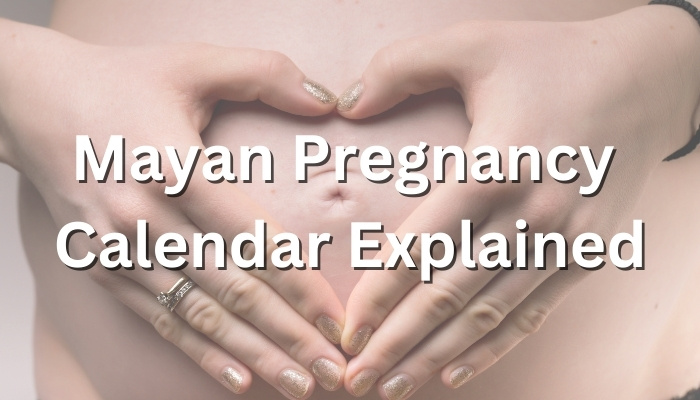Many societies have developed ways to anticipate pregnancy details. The current trend of gender reveal parties suggests that our fixation on our unborn child’s sex remains unchanged over centuries.
However, some of the gender prediction methods are not accurate or scientifically supported.
Though the Mayans used math and numbers to create the Mayan gender chart, it has never been proven scientifically accurate. The Mayan gender chart is probably about as accurate as flipping a coin or guessing. Still, it can be fun to experiment with and see if it ends up being right.
There are different methods for predicting your baby’s gender. Some are geared toward fun, but scientifically backed testing can give you nearly flawless results.
Mayan Gender Prediction Chart
The Mayan gender prediction chart is simple to use once you understand what information you need.
History of the Mayan Gender Prediction Chart
The Mayan gender prediction chart is a lot like the Chinese gender prediction chart.
The Mayans valued math, numbers, and the stars, and they incorporated these into a chart that can supposedly let you know if your baby will be a boy or a girl.
How the Mayan Gender Prediction Chart Works
To use the Mayan gender prediction chart, you need to know how old you were when your child was conceived and what month they were conceived.
Based on the combination of odd and even numbers, the Mayans believed they could tell if a woman was having a boy or a girl.
Two even or two odd numbers mean a girl. An even and odd number combined means a boy.
| Age at Conception | Month of Conception | Baby Gender |
| Even | Even | Girl |
| Odd | Odd | Girl |
| Even | Odd | Boy |
| Odd | Even | Boy |
Mayan Gender Prediction Chart Accuracy
You have a 50/50 chance of the Mayan gender prediction chart being accurate. It’s not scientifically supported.
Mayan Gender Prediction vs. Chinese Gender Prediction
Though both the Mayan and Chinese gender prediction charts use the mom’s age at conception and the conception month, many believe the Chinese chart is more accurate if the lunar age and lunar month are used.
Neither chart is supported by science.
Is It Just an Old Wives’ Tale?
Like most unscientific ways of predicting a child’s gender, the Mayan gender prediction can easily be considered an old wive’s tale.
Though the Mayan people absolutely made discoveries in math, the prediction chart has not proven to be any more accurate than guessing.
Do Gender Prediction Tests Work?
If your goal is simply to have fun, the gender prediction tests are a win. If you are looking for actual accuracy, then gender prediction tests are not the way to go.
However, many people use them at baby showers just for fun, and you can even track what each test says to see which one ended up being accurate.

Fun Ways of Predicting Baby Gender
Have fun with gender prediction tests. Just don’t get too attached to the outcome since they are more about fun than accuracy.
Chinese Baby Gender Prediction Chart
The Chinese baby gender prediction chart is a lot like the Mayan prediction chart. However, many feel that knowing the mom’s lunar age and the lunar month the baby was conceived will render more accurate results.
When you see if these numbers are even or odd, you will be able to plug them into the chart to see if you should expect a boy or a girl.
Baby Gender Ring Test
Got some thread and a ring? Then you are ready to try the baby gender ring test.
Tie the ring to the thread, and have mom lie down on her back. Hold the thread steady over mom’s stomach, and observe which way the ring moves.
If it moves in circles, it’s a girl. If it moves back and forth, it’s a boy. Remember, this is purely for fun.
Baby Gender Pencil Test
Similar to the ring test, the pencil test uses motion to predict gender. You will need to thread a needle and then put the needle securely into the pencil’s eraser.
Have mom lay the back of her hand on a flat surface, inner wrist facing up. Dangle the pencil over moms wrist, and be very still. As the pencil starts to move, pay attention to which way it is moving.
A pencil that moves up and down the length of the arm is predicting a boy. Side to side is predicting a girl.
Baby Gender Needle Test
Simply tie a needle to some thread, and hold it over mom’s open palm. If the needle moves in circles, the prediction is a girl. Back-and-forth motion means a boy.
Baking Soda Test for Gender
You’re going to have to pee a lot anyway, so catch some in a cup of baking soda and predict your baby’s gender.
If the baking soda in a disposable cup fizzes when your urine makes contact, it’s predicting a boy. If not, it’s a girl.
Salt Test for Gender Prediction
If you don’t mind sleeping with a bit of salt on your breast, you can wake up the next morning and see a gender prediction. Salt that grows moist overnight is predicting a girl while dry salt means a boy.
Accurate Ways To Predict Baby Gender
There are many fun ways to predict a baby’s gender, and you can try any just to see what you find.
However, there are also accurate ways to find out the gender of your baby before birth if you truly want to know.
Baby Gender Blood Test
A simple blood test is an accurate way to find out if you are having a boy or a girl. There are different types of tests for you to consider.
Non-invasive prenatal testing can be done at your doctor’s office and simply involves you providing blood during a blood test.
There are also at-home options, such as SneakPeek, Peekaboo, Juno, and eGender.
With these, you prick your finger or insert microneedles into your arm and then send off the blood for results.
If you don’t want to wait for a doctor’s appointment, at-home blood tests are simple and effective.
Wait for Ultrasound Appointment
Your major ultrasound appointment will be around the 20-week mark, and while this is not only to determine gender, your baby’s gender can usually be found at this ultrasound.
Your doctor will look at your child’s development and anatomy to see if there are any issues, but they will also be able to tell you if they saw male or female genitals on the ultrasound.
Chorionic Villus Sampling (CVS)
Chorionic villus sampling involves taking a piece of tissue from the placenta to determine the baby’s gender. This test can also be used to test for abnormalities and genetic issues.
It is considered invasive, so your doctor may not offer this option simply to determine if you are having a boy or a girl.
Amniocentesis
Amniocentesis is a very accurate way to determine your baby’s gender, but it is also extremely invasive.
Amniotic fluid is retrieved from the womb for testing, and this procedure comes with risks. Ask your doctor if there is any reason to try amniocentesis instead of exploring other options.
Related Questions:
How Accurate Is the DNA Blood Test for Gender?
When done correctly, the DNA blood test for gender is between 99-100% accurate.
Who Determines Baby Gender?
Dad, or the sperm he contributes, ultimately determines the gender of the baby.
Final Thoughts
While it can be fun to guess what gender your baby will be, many ways of predicting aren’t scientifically supported.
Use proven screening methods if you really want to know the gender of your child before birth.
Kristy is the mother of four, including identical twins. With a background in education and research, she is constantly learning more about parenting and raising multiples. When she has spare time, she enjoys hiking into the woods with a great book to take a break.

